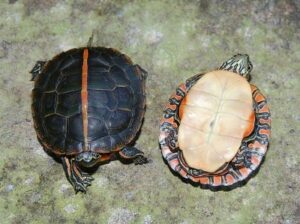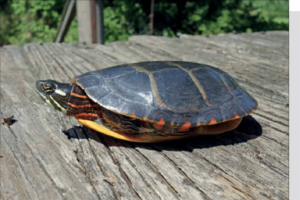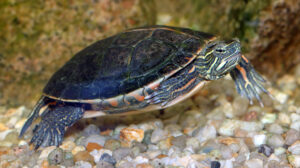Curious about whether your pet turtle hibernates? It’s a question many turtle owners ponder. Understanding your pet’s hibernation habits is key to their well-being. So, do pet turtles hibernate?
Yes, some pet turtles do hibernate, while others may not. The decision to hibernate can depend on various factors such as species, age, health, and environmental conditions. It’s essential for turtle owners to be aware of their specific turtle’s needs and behaviors regarding hibernation.
If you’re unsure whether your pet turtle hibernates, it’s best to consult with a veterinarian or do some research specific to your turtle’s species.
Understanding Turtle Hibernation

Turtle hibernation, also known as brumation, varies depending on the species and the environment they inhabit. Unlike mammals that enter a deep sleep-like state during hibernation, turtles undergo a slowed-down metabolic state.
- Trigger: Hibernation in turtles is typically triggered by environmental cues such as decreasing temperatures and shorter daylight hours. These cues signal to turtles that it’s time to prepare for the colder months ahead.
- Preparation: Before hibernation, turtles often seek out a safe and sheltered location where they can remain relatively undisturbed. This might be burrowing into mud at the bottom of ponds or finding crevices on land.
- Metabolic slowdown: During hibernation, a turtle’s metabolic rate decreases significantly. This allows them to conserve energy while surviving on stored fat reserves. Their heart rate and breathing slow down, and they become less responsive to external stimuli.
- Respiration: Turtles are air-breathing reptiles, so even during hibernation, they need access to oxygen. Aquatic turtles hibernate underwater but surface occasionally to breathe. Terrestrial turtles may hibernate in burrows or under leaf litter, where there’s still enough oxygen to sustain them.
- Duration: The duration of hibernation varies depending on factors such as species, geographic location, and environmental conditions. In colder regions, hibernation may last several months, while in warmer areas, it might be shorter.
- Emergence: As temperatures begin to warm in the spring, turtles gradually emerge from hibernation. They may become more active and start to forage for food to replenish their energy reserves.
- Health concerns: While hibernating, turtles are vulnerable to disturbances, predators, and environmental changes. It’s crucial to avoid disturbing hibernating turtles as they may expend precious energy reserves or become stressed, which could harm their health.
Understanding turtle hibernation is essential for their conservation and well-being, as disturbances during this vulnerable period can have significant impacts on their survival.
Do pet turtles hibernate?
Pet turtles may not hibernate in the same way as their wild counterparts. This is because their environment is typically controlled, and they may not experience the same environmental cues that trigger hibernation in the wild. However, some pet turtles may still exhibit behaviors that resemble hibernation under certain conditions.
- Temperature and Light: In captivity, pet turtles are often kept in environments with stable temperatures and lighting provided by artificial heat sources and UVB lamps. Without significant changes in temperature and daylight hours, pet turtles may not enter hibernation naturally.
- Behavioral Changes: Despite controlled environments, some pet turtles may still exhibit reduced activity and decreased appetite during the winter months. This could be due to factors like cooler temperatures and shorter daylight hours, which may mimic the conditions that trigger hibernation in the wild.
- Artificial Hibernation: Some turtle owners choose to induce a hibernation-like state, known as “brumation,” for their pet turtles. This involves gradually reducing temperatures and daylight hours over a period of time to simulate winter conditions. However, inducing brumation in pet turtles requires careful monitoring to ensure their health and safety.
- Health Considerations: Before attempting to induce brumation in a pet turtle, it’s essential to consider their health and nutritional status. Turtles should be in good health and have adequate fat reserves to safely undergo brumation. Consulting a veterinarian experienced with reptiles is recommended before attempting to induce hibernation in a pet turtle.
Which turtle species hibernate?

Several turtle species exhibit hibernation or brumation behaviors, especially those inhabiting regions with cold winters. Some of the turtle species known to hibernate include:
- Box Turtles: Eastern box turtles (Terrapene carolina) and other box turtle species are known to hibernate. They typically dig into the soil or leaf litter to hibernate during the winter months.
- Painted Turtles: Painted turtles (Chrysemys picta) are semi-aquatic turtles found in North America. In colder regions, they may hibernate underwater in ponds or slow-moving streams.
- Snapping Turtles: Common snapping turtles (Chelydra serpentina) are also known to hibernate. They may bury themselves in mud at the bottom of ponds or lakes during the winter.
- Wood Turtles: Wood turtles (Glyptemys insculpta) are found in North America and may hibernate in burrows or beneath leaf litter.
- Map Turtles: Some species of map turtles (Graptemys) are known to hibernate, particularly those inhabiting colder regions.
- European Pond Turtles: European pond turtles (Emys orbicularis) found in Europe may hibernate in mud at the bottom of ponds or rivers during the winter.
- Russian Tortoises: While not turtles, Russian tortoises (Agrionemys horsfieldii) are tortoise species that hibernate. They are native to arid regions of Central Asia and may hibernate during colder months.
These are just a few examples, and hibernation behaviors can vary among different turtle species and populations. It’s important to note that not all turtle species hibernate, particularly those inhabiting tropical or subtropical regions where temperatures remain relatively warm year-round.
Factors Affecting Turtle Hibernation
Several factors can influence turtle hibernation, including environmental conditions, species-specific behaviors, and individual health. Here are some key factors:
- Temperature: Temperature plays a crucial role in triggering hibernation in turtles. As temperatures drop, turtles may enter a hibernation-like state to conserve energy. Warmer temperatures can delay or prevent hibernation altogether, while colder temperatures can prompt turtles to seek out hibernation sites.
- Daylight Hours: Changes in daylight hours, particularly decreasing daylight during the fall and winter months, can signal to turtles that it’s time to prepare for hibernation. Shorter days and longer nights are often environmental cues for turtles to slow down their metabolism and enter a hibernation state.
- Food Availability: Turtles may adjust their hibernation patterns based on food availability. In regions where food becomes scarce during the winter months, turtles may hibernate for longer periods to conserve energy until food becomes more abundant in the spring.
- Water Availability: Aquatic turtles may hibernate in water bodies such as ponds, lakes, or slow-moving streams. The availability of suitable hibernation sites, including depth, water quality, and oxygen levels, can influence where and how turtles hibernate.
- Species-Specific Behaviors: Different turtle species have evolved specific hibernation behaviors suited to their habitats and environmental conditions. Some turtles may hibernate underwater, while others hibernate on land in burrows or beneath leaf litter.
- Health and Body Condition: The health and body condition of individual turtles can affect their ability to hibernate. Turtles need to have sufficient fat reserves and be in good overall health to withstand the metabolic demands of hibernation. Sick or weakened turtles may not survive hibernation.
- Predation Risk and Disturbance: Turtles may select hibernation sites that offer protection from predators and minimize disturbances. Human activities, such as construction, habitat destruction, or recreational activities, can disrupt hibernating turtles and cause stress or injury.
Understanding these factors is essential for conserving turtle populations and minimizing human impacts on hibernating turtles. Conservation efforts should aim to preserve suitable hibernation habitats and minimize disturbances during the hibernation period.
Hibernation Habits of Different Turtle Species
Different turtle species have evolved unique hibernation habits suited to their specific habitats and environmental conditions. Here’s a look at the hibernation habits of several turtle species:
- Eastern Box Turtle (Terrapene carolina):
- Habitat: Found in woodlands, grasslands, and meadows across eastern North America.
- Hibernation: Eastern box turtles typically hibernate during the winter months. They dig into the soil or leaf litter to create a hibernation chamber, often in wooded areas or under vegetation. Some may also hibernate in burrows or other underground shelters.
- Painted Turtle (Chrysemys picta):
- Habitat: Semi-aquatic turtles found in ponds, lakes, marshes, and slow-moving streams across North America.
- Hibernation: Painted turtles hibernate underwater in ponds or lakes. They may bury themselves in mud at the bottom of water bodies to escape freezing temperatures. Painted turtles can remain active under the ice and may occasionally surface to breathe during hibernation.
- Common Snapping Turtle (Chelydra serpentina):
- Habitat: Found in freshwater habitats such as ponds, lakes, rivers, and marshes throughout North America.
- Hibernation: Common snapping turtles hibernate underwater, often buried in mud at the bottom of ponds or lakes. They can tolerate low oxygen levels and may remain dormant for several months during the winter.
- Wood Turtle (Glyptemys insculpta):
- Habitat: Wood turtles inhabit forested streams, rivers, and wetlands in northeastern North America.
- Hibernation: Wood turtles typically hibernate on land, often in burrows or beneath leaf litter near water bodies. They may dig into the soil to create a hibernation chamber or use existing burrows for shelter during the winter months.
- European Pond Turtle (Emys orbicularis):
- Habitat: Found in freshwater habitats such as ponds, lakes, rivers, and marshes across Europe and parts of Asia.
- Hibernation: European pond turtles hibernate underwater in ponds, lakes, or slow-moving rivers. They may bury themselves in mud at the bottom of water bodies to escape freezing temperatures during the winter.
- Blanding’s Turtle (Emydoidea blandingii):
- Habitat: Found in wetlands, marshes, and shallow ponds across North America.
- Hibernation: Blanding’s turtles typically hibernate in aquatic habitats, often buried in mud at the bottom of ponds or wetlands. They may also hibernate on land in burrows or under vegetation near water bodies.
These examples illustrate the diverse hibernation habits of different turtle species, highlighting how they have adapted to survive winter conditions in various terrestrial and aquatic environments.
Monitoring Your Pet Turtle During Hibernation

Monitoring your pet turtle during hibernation is crucial to ensure its health and well-being. Here are some important steps to follow:
- Know Your Turtle: Understand your turtle’s species-specific hibernation requirements. Not all turtle species hibernate, and even among hibernating species, individual turtles may have different hibernation patterns.
- Health Check: Before hibernation, ensure that your turtle is in good health. A veterinary check-up can help confirm your turtle’s health status and readiness for hibernation.
- Prepare the Hibernation Setup: If you choose to induce hibernation for your pet turtle, set up an appropriate hibernation enclosure. This may include a container filled with damp substrate (such as soil or peat moss) and placed in a cool, dark location.
- Temperature and Humidity Monitoring: Regularly monitor the temperature and humidity levels in the hibernation enclosure. The temperature should be cool but above freezing, typically around 4-10°C (40-50°F), while humidity levels should remain relatively high to prevent dehydration.
- Periodic Checks: While your turtle is hibernating, periodically check on it to ensure it’s alive and healthy. Gently touch or nudge your turtle to see if it responds. If your turtle moves or shows signs of activity, it’s likely healthy. However, if your turtle remains unresponsive, it may be in deep hibernation or potentially deceased.
- Hydration: Although turtles can go for extended periods without food during hibernation, dehydration can still be a concern. Ensure that your turtle has access to water, either by misting the substrate or providing a shallow dish of water if it’s a species that can safely hibernate underwater.
- Disturbance Minimization: Minimize disturbances to the hibernation enclosure to avoid disrupting your turtle’s hibernation cycle. Keep noise levels low, and avoid handling or disturbing your turtle unnecessarily.
- End of Hibernation: As temperatures begin to warm in the spring, gradually transition your turtle out of hibernation. Slowly increase temperatures and daylight hours in the enclosure to mimic the changing seasons. Offer your turtle small amounts of food once it becomes active again.
- Veterinary Care: If you have any concerns about your turtle’s health or hibernation behavior, consult a veterinarian experienced with reptiles for guidance and assistance.
By closely monitoring your pet turtle during hibernation and providing appropriate care, you can help ensure its safety and well-being throughout the winter months.
Bringing Your Turtle Out of Hibernation
Bringing your turtle out of hibernation, also known as “waking up” your turtle, requires a careful and gradual process to ensure its health and well-being. Here are the steps to follow:
- Temperature and Lighting Adjustment:
- Gradually increase the temperature and lighting in the hibernation enclosure over the course of several days to mimic the warming temperatures of spring. This can be achieved by adjusting the thermostat on heating devices and gradually increasing the duration of lighting provided by UVB lamps.
- Observation:
- Monitor your turtle closely as it begins to emerge from hibernation. Look for signs of activity such as movement, stretching, or opening of the eyes. It’s normal for turtles to be lethargic and slow-moving initially.
- Hydration:
- Offer your turtle a shallow dish of clean, dechlorinated water to drink. Rehydrate your turtle slowly to prevent overhydration, especially if it has been without water for an extended period during hibernation.
- Feeding:
- Once your turtle is fully awake and active, gradually reintroduce food into its diet. Start with small, easily digestible meals such as leafy greens or commercial turtle pellets. Avoid offering large meals or protein-rich foods initially, as turtles may have a reduced appetite coming out of hibernation.
- Warm-Up Period:
- Allow your turtle to bask under a heat lamp or UVB lamp for a few hours each day to help raise its body temperature. Turtles need warmth to stimulate their metabolism and digestion after hibernation.
- Health Check:
- Take this opportunity to perform a thorough health check on your turtle. Look for any signs of illness or injury, such as abnormal behavior, lethargy, swelling, or abnormal growths. If you notice any concerns, consult a veterinarian experienced with reptiles for guidance.
- Gradual Reintroduction to Normal Habitat:
- Once your turtle has fully awakened from hibernation and resumed normal activity, gradually reintroduce it to its regular habitat. Monitor its behavior and adjust environmental conditions as needed to ensure its comfort and well-being.
- Regular Care and Monitoring:
- Resume your regular care routine for your turtle, including providing appropriate diet, lighting, temperature, and habitat conditions. Continue to monitor your turtle closely for any signs of health issues or abnormal behavior.
By following these steps and being patient with your turtle’s natural awakening process, you can help ensure a smooth transition out of hibernation and promote its health and well-being.
Conclusion
In considering the question, Do pet turtles hibernate, it’s important to recognize the diverse responses and factors involved in the hibernation habits of pet turtles. While some pet turtle species may exhibit behaviors resembling hibernation, the practice of hibernation among pet turtles varies.
Factors such as species, environmental conditions, and captivity settings play significant roles in determining whether pet turtles hibernate.

